19 Proven Content Marketing Tips From Industry Experts in 2025
Content marketing is an effective SEO strategy for digital publishers. Unless you are a big premium publisher, you might be struggling to attract traffic to your website or convert your readers into paying customers. So, how do you do it?
By utilizing content marketing! This technique aims to deliver high-quality content to help your site rank higher, upsell your additional services, and increase your expertise.
In today’s round-up, you’ll learn 19 effective content marketing tips from industry experts, covering everything from planning and creation to distribution, to help you rank higher in 2025.
1. Optimize Content for Search Intent
Optimizing your content for search intent is arguably one of the most important things in content marketing. If the content doesn’t speak to your target audience and doesn’t provide relevant information, it won’t rank.

“One of the major changes we’ve made to our strategy was putting more emphasis on search intent. It’s no longer enough to just find keywords; it’s also important to understand the why behind those searches. Users aren’t just looking for random content that happens to include a keyword—they’re looking for answers to problems or questions.
So, instead of just chasing high-volume keywords, we examine the intent behind those searches. Suppose someone searches for how to improve video engagement, but we don’t list generic tips. We provide in-depth insights, case studies, and actionable steps relevant to what the user is seeking. This focus on intent has improved our ranking and increased engagement and conversions because the content is useful.” – Spencer Romenco, Chief Growth Strategist at Growthspurt
Search intent aims to discover what the user truly wants to find. To craft your content with search intent in mind, you need to analyze the top-ranking pages for your target keyword based on the 3 Cs of search intent.
The 3 Cs of search intent are:
- Content type (blog posts, video, product pages, category pages, landing pages)
- Content format (how-to guides, step-by-step tutorials, list posts)
- Content angle (content freshness, product comparison)
Content type
Content type helps to understand what content will perform best for a specific topic. For example, if the user searches for a term “how to set up instagram shop,” we can see that the top results are primarily videos.
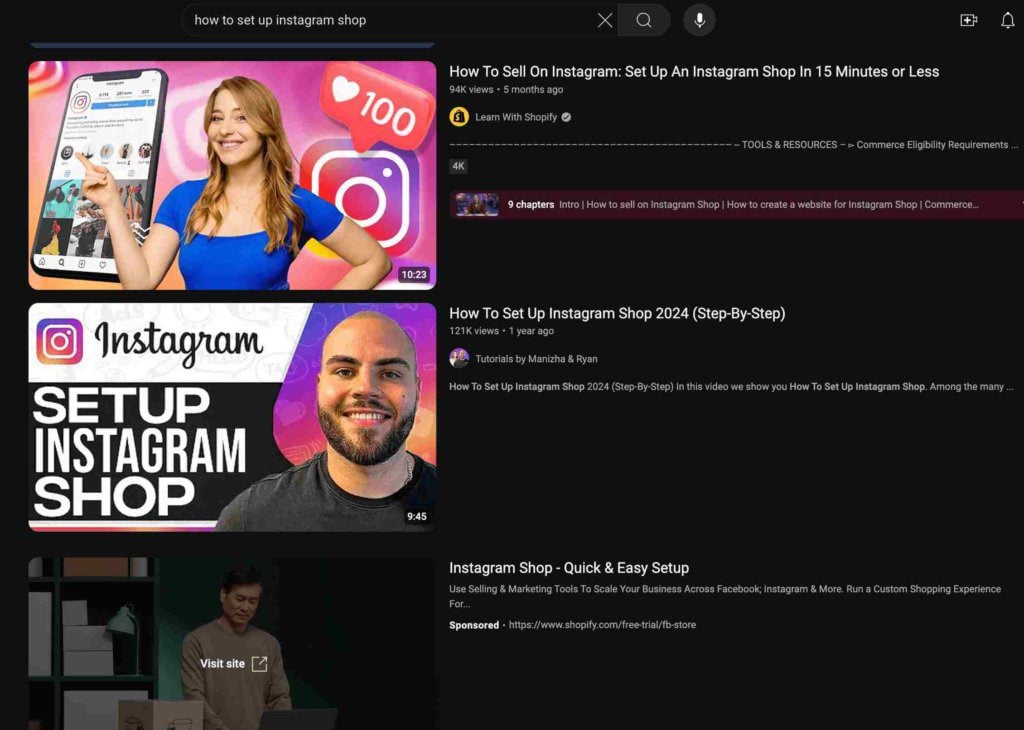
So, you will likely need to create a video to rank for this keyword.
Content format
Identifying the content format allows you to create content users are most likely to read.
For example, the top-ranking results page for “best adsense alternatives” are listicles that include comparisons of multiple Google AdSense alternatives.
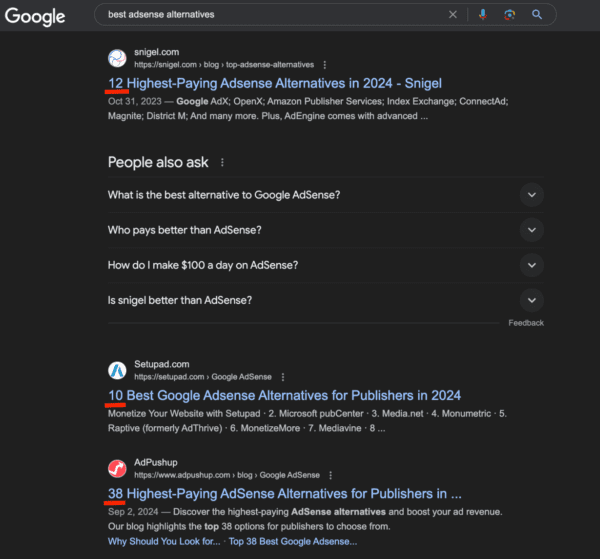
Content angle
The content angle refers to the benefit the reader will get from reading your content. For example, people searching for “winter fashion trends” will likely expect to find information relevant to this season’s fashion. So, it makes sense that most top-ranking pages include the year.
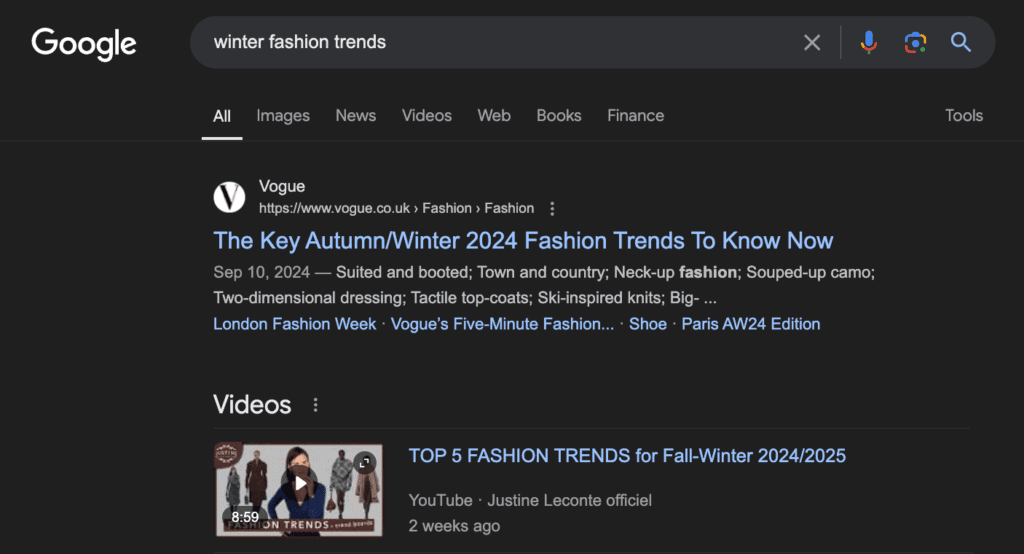
2. Utilize Google Trends
Google Trends is a free feature that shows how popular a search term is on Google in a given time. It allows you to see the search frequency of a given term based on countries, search volume, and even its relative popularity compared to other terms.
What’s great about it is that it gives you a relative understanding of trending topics and helps avoid topics that are losing popularity.
For example, in early 2020, Google announced that it would phase out all third-party cookies from its Chrome browser by 2022 (later postponed to 2023).
As seen from the graph, it sparked a huge interest in the topic compared to just a few months before the announcement.
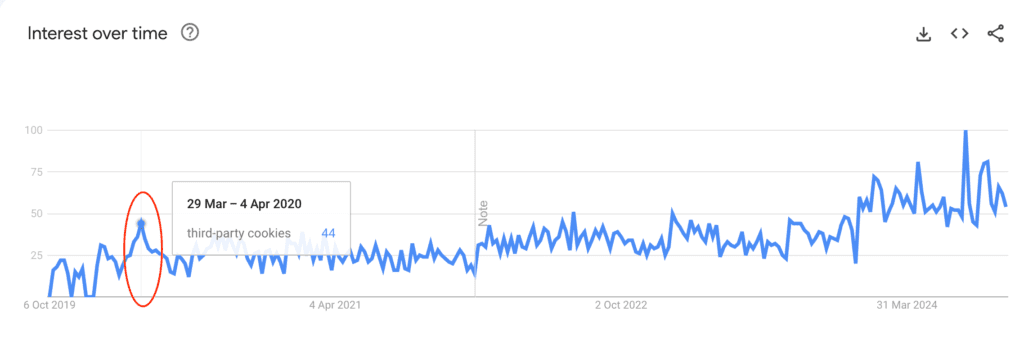
3. Update Existing Content
You can extend the life of your content and improve your rankings by updating and resurfacing some of your older but well-performing content.
This content marketing technique is highly effective. Firstly, Google prefers fresh content. Secondly, it allows you to rank for more keywords than you originally have, which will attract more users to your page.
A screenshot below demonstrates the increase in pageviews after we updated our article about how to monetize a website in 2022.

There are 2 great ways to perform an effective content update:
- Add original data to your content
- Run a content gap analysis on a page level

“Unique content is key if you want to rank higher in search engines. Duplicate content, where the same or very similar content appears on different URLs, can hurt your site. Search engines, like Google, favor pages with unique content, so duplicate content can mean lower rankings, less organic traffic, and fragmented link equity.
This isn’t just about duplicate blog posts or articles. It’s also about technical duplicates caused by poor content management, wrong server setup, or pagination errors. To avoid these problems, focus on consolidating your content under one URL, using canonical tags where necessary, and ensuring your site’s structure supports unique content delivery. This technical housekeeping helps search engines understand your content better and makes your site more efficient and user friendly.” – Jase Rodley, SEO Consultant
Add original data to your content
Supporting your content with original data doesn’t only provide a unique angle to your content but also tends to generate social shares, likes, and inbound links. Infographics, charts, and tables are all great examples of original data. And are easy enough to create using various infographic template tools or data processing and visualization tools.

Run a content gap analysis on a page level
How do I decide what information to add to my content? Well, there are tools to help you out.
Most SEO tools offer content gap analysis features. Usually, you’d compare your page with your competitors and find content gaps at the domain level.
However, you can also run content gap analysis on a page level to make existing content more in-depth by adding missing subtopics.
Just analyze a few top-performing pages for your target keyword and identify keywords they’re ranking for, but your page doesn’t. If you’re not ranking for these keywords, usually that’s an indicator that you’re not covering this subtopic in your content.
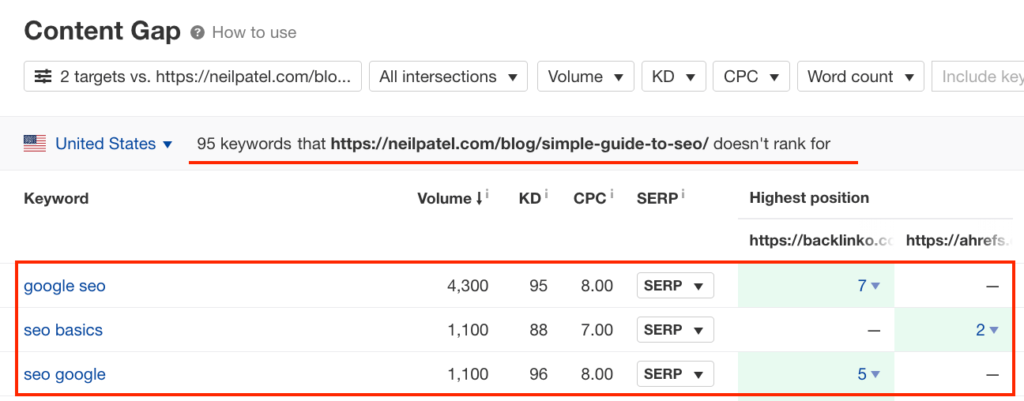
4. Diversify Your Content
Not all content types are made equal. Therefore, it’s important to determine which type of content would benefit your business goals.
Your content portfolio should reflect the goals of your business. For example, if your goal is to build brand authority, consider gathering data for reports and whitepapers relevant to your industry.
If you wish to upsell your service, you can create YouTube videos and showcase your product in a product explainer video. Don’t forget to include the videos in your blog posts.
Another fantastic way to generate more traffic to your website is to create a free tool that will keep visitors come back.
The content marketing matrix is a great place to gather ideas for content diversification.
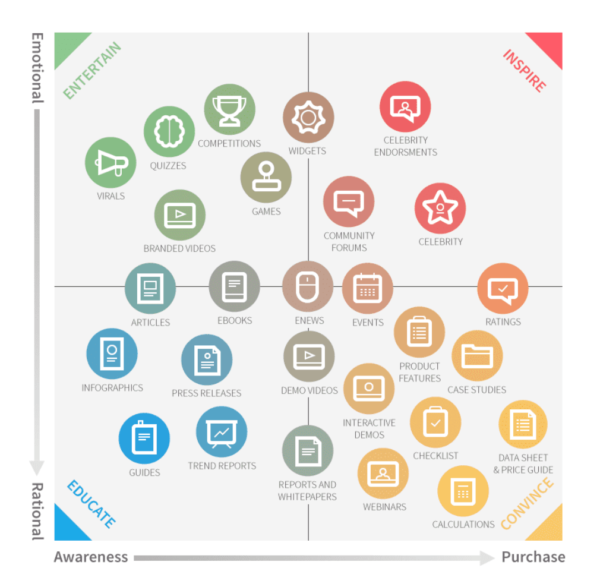
Source: SmartInsights
5. Create the Right Social Media Content
Defining your social media target audience is just as important as defining your business’s target audience. Having a presence on social media can hugely help with your discoverability and brand awareness.
There are a plethora of social media management tools available for marketers, but more important for you as a marketer is to understand your audience’s needs.
However, to craft content that will speak to your social media audience, you need to ask yourself: “What content performs best in this environment?”
For example, Instagram is a platform centered around short, snappy, and highly visual content. Now, having this in mind, you can start defining the goals for your content. A helpful framework to decide on the type of content that will work best is the 5 E’s of content:
- Educate
- Entertain
- Engage
- Enrich
- Evolve
For example, creating content to entertain should be built around forming a relationship. The goal should be to trigger an emotion. If you have a team, it’s a good idea to show who they are and what they do. It builds trust between your brand and your users.
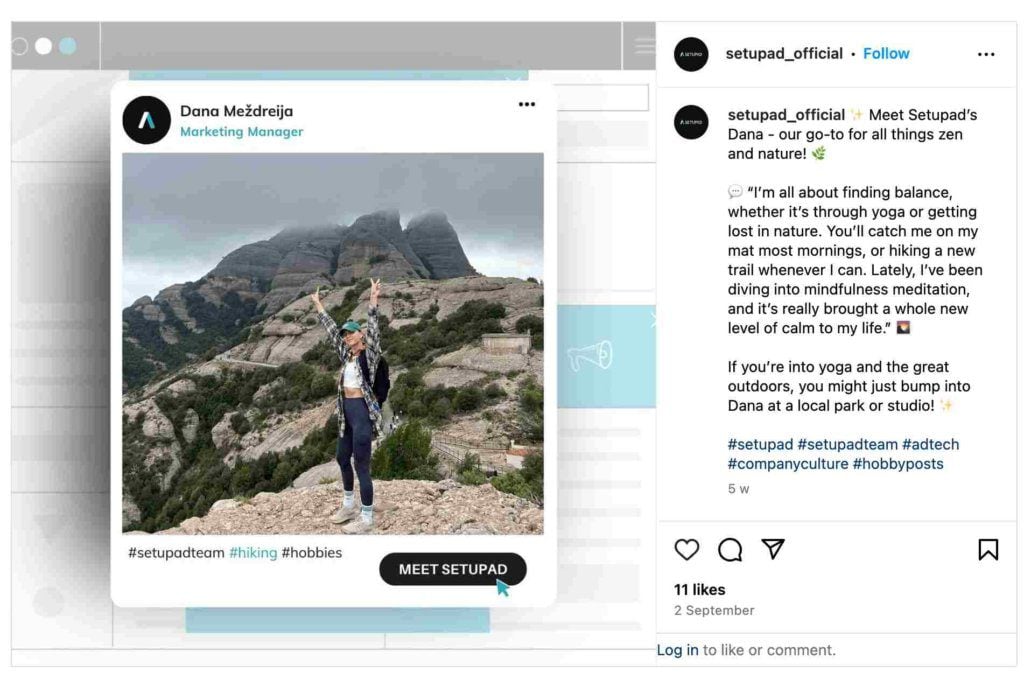
Similarly, content to engage can be used to give your users a taster of how your product or tool can help them.
Ultimately, your content must be visually appealing to your audience, or you won’t get a lot of traction. To make attractive content, you can use one of the many photo editor applications out there.
For example, Picsart’s photo editor is AI-powered and built for your content needs. With its intuitive interface and drag-and-drop features, you can crop, resize, and adjust colors on your photos with a single click. You can also use its AI image generator to make unique images.
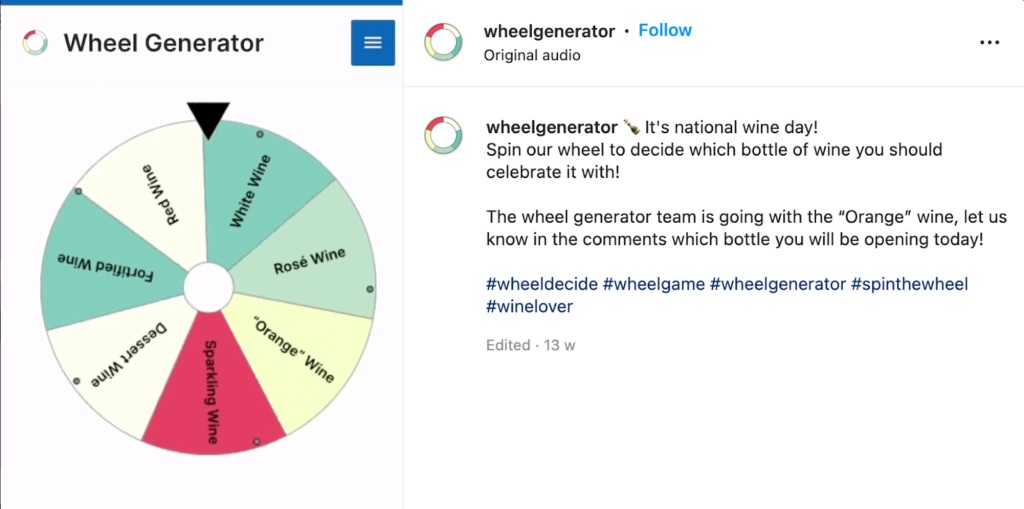
6. Promote Your Content on Public Forums
Reddit is the 5th most popular website in the US, surpassing Instagram and Wikipedia. It’s often among the first pages in SERP with a DR of 95.
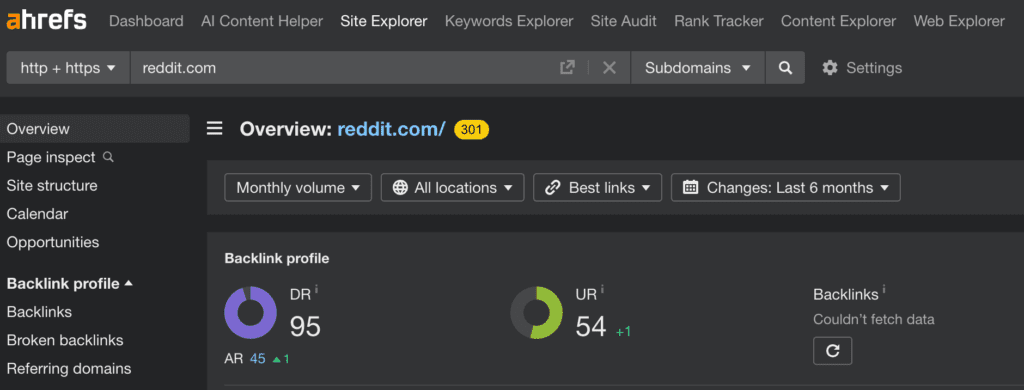
Reddit is a community-based platform with highly engaged audiences and strict content guidelines, which means they don’t allow self-promotion activities.
However, if you meaningfully engage in discussion and provide users with relevant information, you’re welcome to drop a link to your website. As simple as that!
This technique is great for attracting new audiences and building your brand’s authority. It’s also highly beneficial for your Google’s E-A-T score.
Although links from these domains are usually no-follow links, they’re still highly beneficial to your backlink portfolio.
7. Identify Opportunities For Inbound Links
Inbound links, or backlinks, are among the top Google ranking factors. There is a clear correlation between the number of referring domains that are linking to your site and the website’s organic traffic.
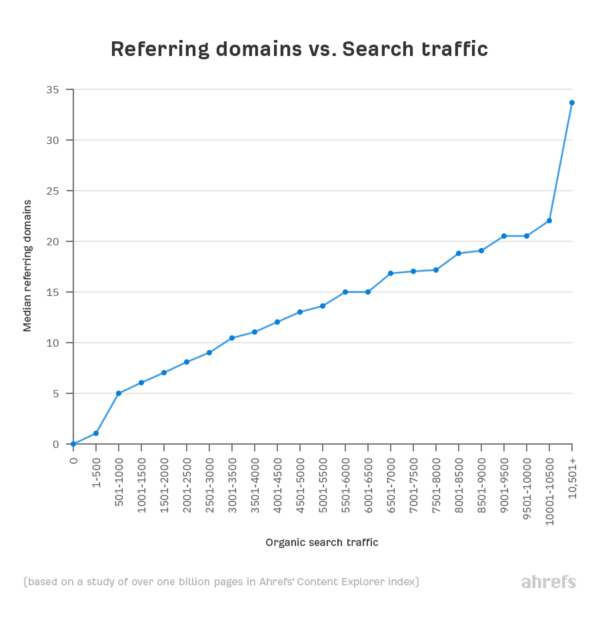
Source: Ahrefs
When creating content, you should try to understand why people are linking to the pages you want to outperform.
By looking at the anchor text from referring domains, you can get insight into why this content generates inbound links.
For example, if we look at the keyword “unified ID,” we’d see that The Trade Desk page has backlinks from 879 referring domains. Why are so many websites linking to this webpage in the first place?

Let’s open the “Anchors” report under the Site Explorer tab in Ahrefs. We’d see that the overwhelming majority of referring domains link to this page because of one concept: “Unified ID 2.0”. This concept relates to the solution developed by The Trade Desk, which is now used interchangeably with the term “unified ID.”

By looking at this report, you can gain insight into what your own content needs. If you find that people are linking to a page because of a stat, then you might also consider running a survey or creating a data report.
8. Optimize Meta Description
A meta description is a companion to the title tag. In other words, it offers the reader a summary of what will be covered in the post.
Having a catchy meta description entices more people to click on your webpage in the search results. While meta description isn’t a ranking factor, Google pays attention to the click-through rate (CTR), which a good meta description can influence.
Using a clear call-to-action (CTA) allows you to attract more people to your site while also letting your readers know what they should expect when they click. Depending on your content, you can use CTAs like “Sign up now” or “Learn more.”
If you want your meta description to display fully on all devices, don’t exceed 160 characters.
Pro Tip!
To generate meta descriptions ideas, use a free Google Chrome extension SEO Meta in 1 Click to quickly access meta data for any page.

9. Optimize Table of Contents
A table of contents can be a great help when it comes to readability. In addition, it allows the readers to understand if the topics covered in the post are worth their while.
However, another benefit of having a table of contents is that it often generates anchors on the page, which can appear in SERP or featured snippets.
Pro Tip!
It often makes sense to write your table of contents in a bulleted or numbered list, which can boost your chances to appear in featured snippets. The bulleted list captures 37% of the snippet results.
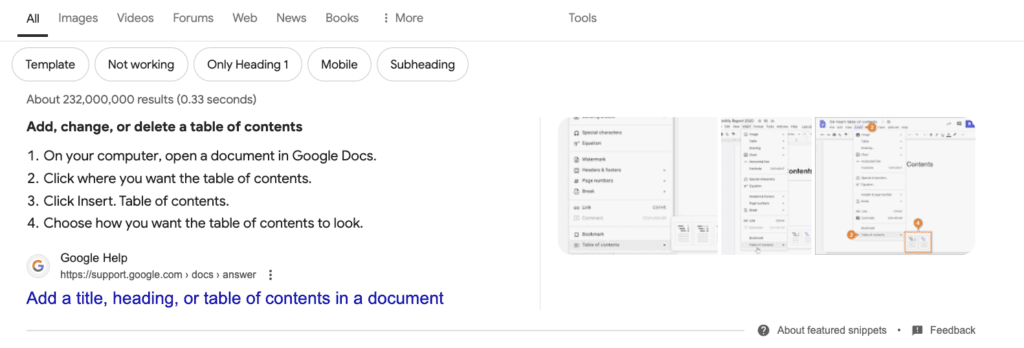
And there you have it, better user experience and readability!
10. Get High-Quality Backlinks
Backlinks from authoritative sites signal to search engines that your content is trustworthy and relevant. This, in turn, can boost your domain’s authority. The more credible backlinks you have–the more likely search engines like Google will rank your content higher, increasing visibility and organic traffic.
Focusing on quality over quantity is essential. But so are partnerships–remember, everyone you interact with is human. Fostering genuine relationships can unlock bigger opportunities, even when you’re looking for backlinks.
11. Research Your Keywords
Researching your keywords is a foundational step in any content marketing strategy. By understanding the search terms your target audience is using, you can create content that directly addresses their needs and interests.
Proper keyword research helps you identify gaps in your industry, discover trending topics, and rank higher on SERPs.

“In my experience, the foundation of any successful content marketing strategy is identifying high-quality articles that have the potential to rank well. Once you find those, the next step is to propose relevant, well-researched keywords that match search intent and have realistic competition levels.
When proposing keywords, I prioritize those closely aligned with the article’s subject matter and audience’s needs. This makes the content more relevant, improves visibility, and often results in better engagement metrics like time on page and click-through rates. This process of marrying the right article with the right keyword proposal is, in my experience, one of the most important strategies for driving traffic and building authority over time.” – Viktoria Medvedko, founder and link-building strategist at Getmentioned Today
Make sure to use tools that can help you, like Google Keyword Planner, Ahrefs, and SEMrush, which can provide insights into search volume, competition, and keyword difficulty, guiding your strategy to focus on high-impact keywords that offer the best chance for visibility.

“It’s funny. I used to rely on just one or two tools, thinking I was killing it. Nope. I’ve since learned to combine data from multiple sources like Google Keyword Planner, Ahrefs, and even good old Reddit to get the full picture.
Trust me, nothing beats finding those niche keywords that others are missing. As someone who runs a link-building agency, I’ve seen firsthand how various SEO strategies impact rankings, and one of the most critical factors is finding the right articles to target and proposing strategic keywords.” – Dammy Ade, Digital Marketer and SEO Specialist
Using relevant keywords strategically within your content boosts its relevance and discoverability. However, it’s not just about stuffing keywords–context and natural language matter more than ever.
Search engines are increasingly sophisticated, prioritizing content that provides genuine value to users. By researching and selecting the right keywords, you align your content with your audience’s search intent, increasing your chances of driving organic traffic and engagement.
12. Leverage the Power of AI
AI’s capabilities go beyond simple automation–it empowers marketers to create high-quality, personalized content at scale. AI tools are used extensively for content creation, data analysis, and predictive analytics, enabling faster, data-driven decisions that lead to more effective marketing campaigns.
AI is a game-changer when you know how to use it!
Companies that adopt AI for content marketing report significant improvements in SEO, engagement, and overall content quality, making it a critical tool for staying ahead in the industry.
AI also drives personalization and better user experiences by analyzing large datasets. The customization it can bring boosts engagement and aligns with search engines’ focus on delivering relevant results.
While AI-generated content can streamline processes, experts emphasize the need for human oversight to maintain authenticity and creativity.

“The biggest challenge Google has right now is overcoming the flood of AI generated content being posted by websites. If Google returns a search result containing 10x AI written articles, that essentially rehash the same information, then that’s a poor user experience for searchers and it will ultimately hurt Google’s brand.
Recognising this, Google has doubled down on rewarding content that clearly displays first-hand experience and expertise, two elements that AI content cannot replicate.” – John Butterworth, founder of Mint SEO agency
13. Create Content Clusters
Creating content clusters is an advanced SEO strategy that organizes your website’s content around a central topic, a pillar page, and connects related subtopics through internal links. This structure helps search engines understand the relationship between your content pieces, boosting your site’s authority.
By developing comprehensive clusters, you can cover a topic in-depth and improve your chances of ranking higher in SERPs for various related keywords. This approach drives more organic traffic and encourages users to explore more pages on your site, increasing engagement and session duration.
Content clusters align with search engines’ focus on semantic search and user intent. Utilizing tools like SEMrush and HubSpot can help identify the most effective keywords and topic clusters to optimize your content strategy further.

“What’s been working incredibly well for us is focusing on content clusters. We’ve moved away from isolated blog posts and instead created clusters of related content around key topics. This allows us to interlink related pages, which signals to Google that our site provides comprehensive information on the topics we cover.
Each page within a cluster builds on the others, enhancing our relevance and authority on specific sliding door subjects. It’s also made navigation easier for customers, who can find everything they need in one place. This has improved the user experience significantly, as visitors don’t need to hop between different sections or leave our site to find what they’re looking for.” – Gal Cohen, Business Development Leader & Field Area Manager at JDM Sliding Doors
14. Keep an Eye on Your Traffic
Keeping an eye on your traffic is crucial for understanding the effectiveness of your content strategy. Regularly monitoring metrics like page views, bounce rates, and user engagement helps identify which content resonates most with your audience and where there may be opportunities for improvement.
You should further refine this strategy to focus on high-performing content types, optimize underperforming pages, and spot emerging trends that can guide your future content creation efforts.

“Google increasingly determines rankings on user engagement metrics–how users behave on a page. However, this presents a problem for newly published content. If its not already ranking, than it can’t get the traffic for Google to measure these user engagement signals.
This means that Google is unlikely to ever rank on your page because it has no metrics on which to base your page’s quality. The solution to this is to get non-search traffic to your page as soon as possible. This can be traffic from: a mailing list, social media, or referral traffic from other websites. Getting this initial hit of traffic gives Google some user engagement metrics to work with and, assuming that these metrics are good, it should boost your rankings.” – James Oliver, an SEO consultant and founder of Oliver.com
Advanced tools like Google Analytics, SEMrush, and HubSpot can give you in-depth insights into your traffic patterns, allowing you to track where visitors are coming from, how they interact with your site, and which keywords drive the most organic traffic.
This analysis is vital for maintaining your current rankings and uncovering new content opportunities that align with user intent.
15. Maintain Trust and Credibility
Consistently delivering accurate, well-researched, and transparent content helps position you as an authority in your industry. To enhance credibility, focus on citing reliable sources, avoiding clickbait tactics, and regularly updating your content to reflect the latest developments. Testimonials, case studies, and data-driven insights can further strengthen your brand’s reputation.
Trustworthiness plays a significant role in SEO. Google prioritizes content that demonstrates Experience, Expertise, Authoritativeness, and Trustworthiness (E-E-A-T), which means that maintaining credibility can directly influence your rankings. Responding promptly to user feedback, correcting errors when they occur, and being transparent about your processes are crucial steps.

“One of the most effective strategies I’ve used to boost credibility is by showcasing subject matter expertise. This could be through well-researched content, citing industry experts, or incorporating testimonials and case studies that build trust with the audience.
Google’s E-E-A-T framework is becoming increasingly important, so establishing yourself or your brand as an authority can make a big difference in rankings.” – Felix Milshtein, content marketing expert and Senior SEO Manager at Vcita
16. Optimize Your Images
Properly optimized images can reduce page load times. Techniques such as compressing image files, using descriptive filenames, and adding relevant alt text make your site faster and help search engines better understand your content. For this, you can use tools like Tinyjpg.
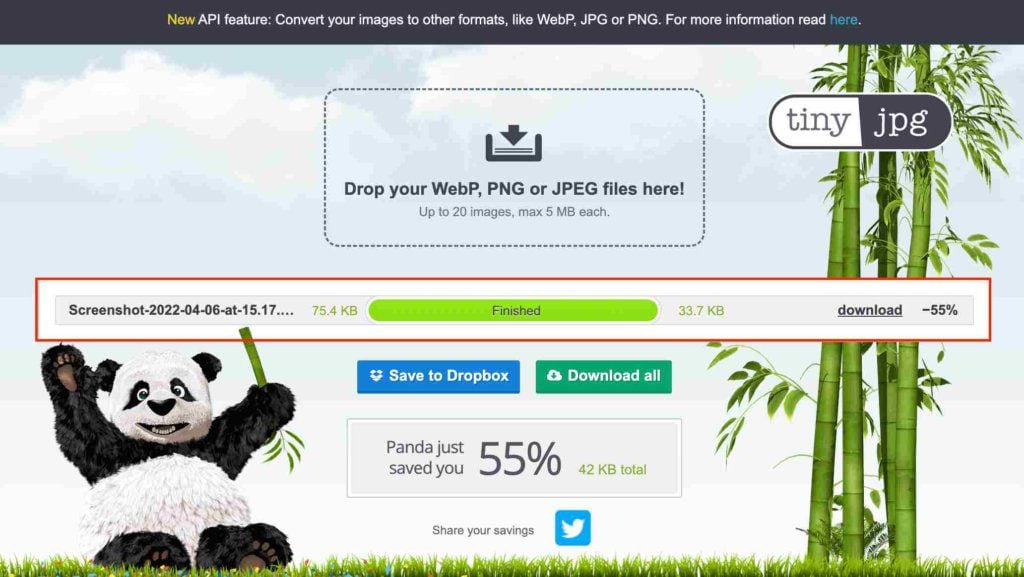
This is essential for appearing in image search results and driving organic traffic to your website. Modern SEO practices also emphasize using the right file formats (like WebP or JPEG for faster loading) and implementing responsive images that adapt to different screen sizes.
Utilizing structured data for images can enhance your visibility by making your content eligible for rich results, such as featured snippets and carousels. By focusing on image optimization, you improve your site’s performance and ensure a smoother experience for your visitors.

“Your visitors want to find what they are looking for quickly, or else they will soon get bored and abandon the site. If this happens, search engines associate this with poor content and relevancy and won’t display you high in the rankings.
Keep a website fast by reducing image sizes and ensuring each page loads quickly. Make sure the messaging is clear, with functionality and user experience smooth and easy – if it requires too many clicks to find what they are looking for, they will leave.” – James Taylor, SEO Strategist at Embryo
17. Work on Accessibility
Working on accessibility is essential for ensuring that all users, including those with disabilities, can interact with your website and content. An accessible site improves user experience and makes your content more discoverable and usable for everyone.

“It’s important to recognize how impactful accessibility can be in your strategy. We’ve witnessed conversion rates leap by as much as 20% when we embrace social proof and follow accessibility guidelines. This approach widens your reach and sends a clear message to search engines–your content is reliable and easy for everyone to navigate.” – Roland Jakob, an entrepreneur and Managing Partner of Blazekin Media
Best practices include using descriptive alt text for images, adding captions to videos, ensuring proper heading structures, and using clear and concise language. These adjustments make it easier for screen readers to interpret your content, enhancing the experience for users with visual or cognitive impairments.
Accessibility also involves optimizing your website’s design to accommodate all devices and assistive technologies. For example, high-contrast color schemes, creating keyboard-navigable elements, and avoiding features like autoplay or flashing content that could cause issues for users with sensory sensitivities.
18. Create Effective Headlines
A compelling headline grabs the reader’s attention, sparks curiosity, and increases the likelihood of engagement. Research shows that 80% of users read the headline, but only 20% click through to read the content. Crafting headlines that attract clicks and align with user intent and search behavior is important.
Effective headlines often use powerful words, numbers, and emotional triggers to capture attention while staying clear and concise about what the reader can expect from the content.
Tomazs Borys, Senoir VP of Marketing & Sales at Deep Sentinel, shared an example case with a headline that exemplifies their approach: “The Top 10 Most Stolen Cars (2025)”. This headline incorporates several key elements that make it both SEO-friendly and appealing to readers:
- It uses a number (10), which is known to attract clicks and improve readability.
- It clearly states the topic (most stolen cars), which is likely a high-interest subject for our security-conscious audience.
- It includes the current year (2025), indicating up-to-date information and helping with SEO for timely searches.
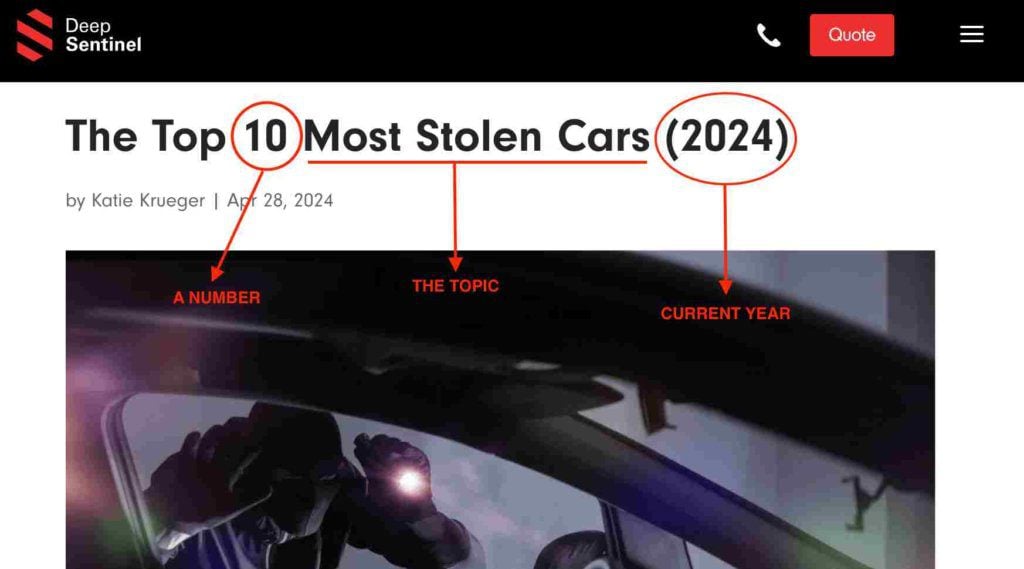
Incorporating SEO best practices into your headline strategy can further boost your content’s visibility. Tools like CoSchedule’s Headline Analyzer or SEMrush’s Title Generator can help you test different variations for effectiveness.

“Title tags are an essential element in your on-page practice, but most people do not focus on them much after they publish blog posts. While you include all the best practices for crafting the title tag when publishing, it’s always the best idea to experiment with it. From our experience working with 100+ law firms, we have seen success in experimenting with SEO titles. Here’s how we do it:
- Export your search console keywords data.
- Figure out how many more clicks you could be getting by subtracting your actual “Clicks” from your “Impressions.” This shows you where there’s scope for improvement.
- Add filter by removing >1% CTR keywords (you can adjust this based on the average CTR data).
- Focus on the keywords with the highest number of “Available Clicks.” These are the terms where you have the biggest opportunity to increase traffic.
- Find the blogs associated with high-potential keywords and test out different titles to see if you can get a higher click-through rate.
- Analyze the top-ranking pages for your target keywords to understand search intent and content angle.
- Based on all these, create compelling titles with relevant keywords, address search intent, and click-worthy elements.
- Test it for at least 1 month for Google algorithm to adjust and compare results.” – Mushfiq Sarker, CEO at LaGrande Marketing
19. Be Innovative and Creative
Being innovative is key to truly stand out and elevate your content marketing strategy.
Innovation means finding unique ways to engage your audience and differentiate your message from the crowded digital landscape. This approach not only boosts your rankings but also positions your brand as a thought leader in your industry.

“One of the best ways I’ve found to build credibility in the SEO content space–in any vertical–and cut through the noise is to focus on information gain. Information gain refers to a relatively new concept in SEO.
The simplified description is simply focusing on adding new information to the ocean of content Google has. If you can do that, the theory is that Google will want to rank you well. It’s a theory, of course, but it’s one I’ve seen have massive benefits in various SEO verticals. It’s also helpful for building credibility with readers because you are seen as a source of new or cutting-edge information.” – Alex Lindley, Founder of Law Firm Content Pros
Instead of repeating what everyone else is saying, focus on delivering fresh insights and perspectives that add value to your audience’s experience. Embracing innovation means continuously looking for ways to provide new value, making your content both authentic and authoritative.
For example, there are many ways to rank for keywords, and the key is to tailor your approach to different platforms, tools, and techniques (like using descriptive alt texts for images). Experimenting with these strategies might just uncover the winning formula that elevates your content’s visibility.

“I have managed to rank in the top 3 on Google for a keyword (virtual summit + how to host a virtual summit) that has lots of competitors with a high DA. My website has a lower DA than all the other results.
This was accomplished through podcast guesting. I went on several podcasts as a guest and shared my story on generating $50,000 from my first virtual summit.” – Liam Austin, Co-Founder & CEO at Entrepreneurs HQ & Talks
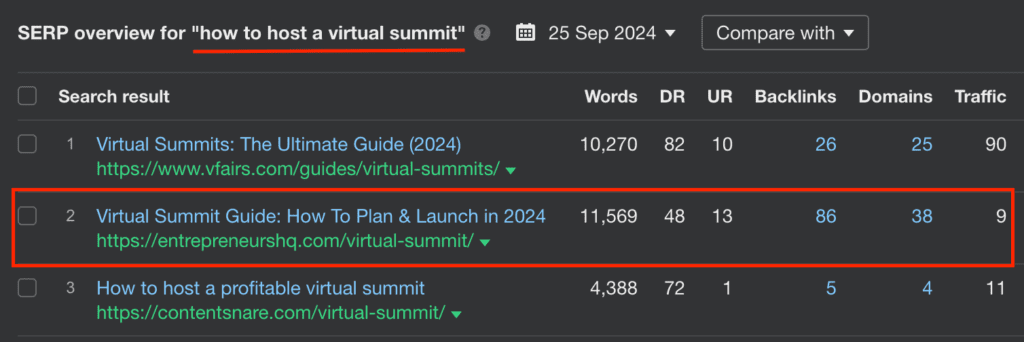
This lead Liam to getting:
- Exposure to a new audience (in this case the podcasters listeners.)
- Backlinks from the podcasters website (this was from the podcast notes where the host linked to my website and in-depth guide on the topic.)
- Authority and credibility by having influencer recommendations.
- Partnerships with influencers in his niche who would become affiliates for his courses and programs.
Wrapping Up
Remember that your content must serve value to your users but also engage them. And for that, you have to think outside of the box.
Before creating any type of content, ask yourself: “Is there a tip or a strategy I can use to make my content even better?”. Then follow these tips and start seeing tangible results.


